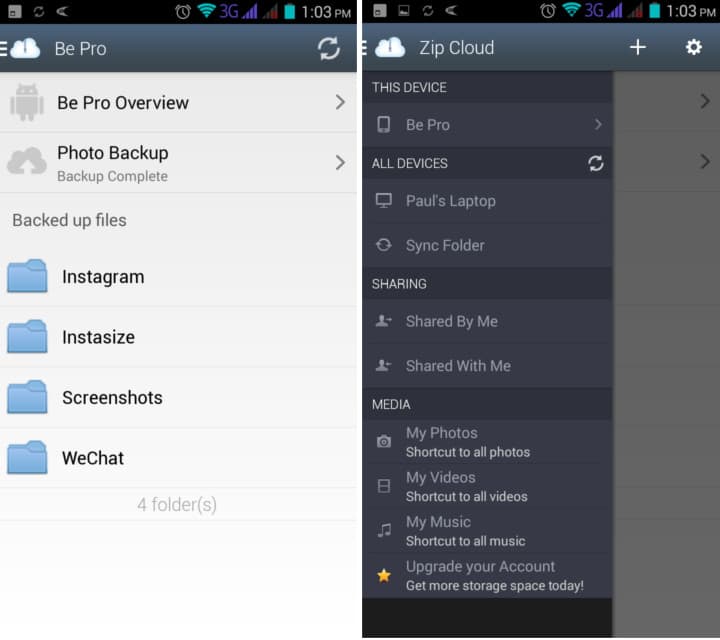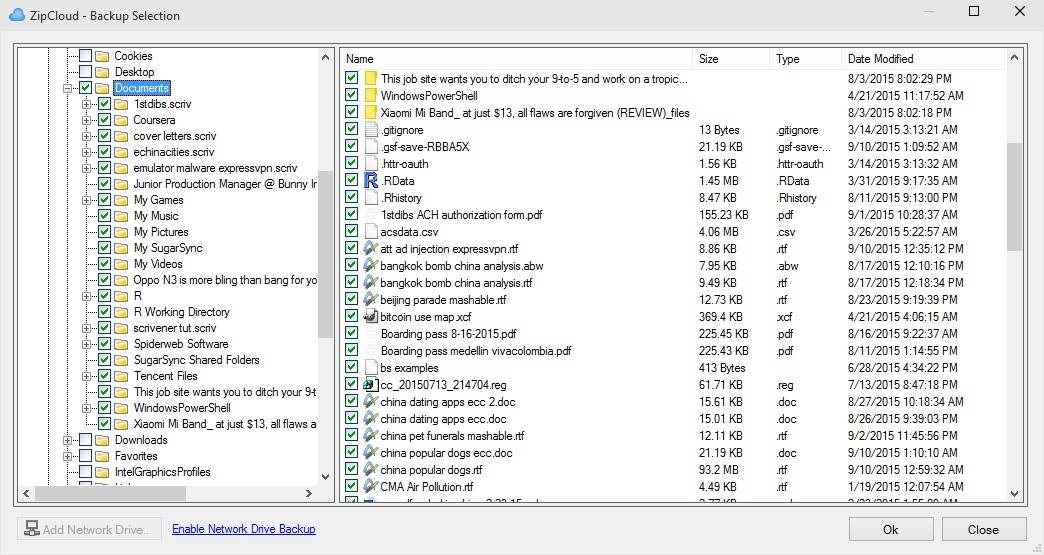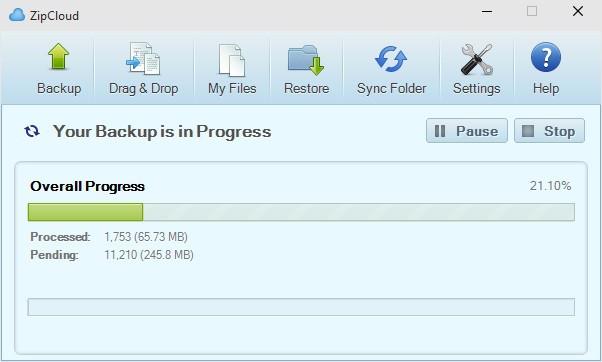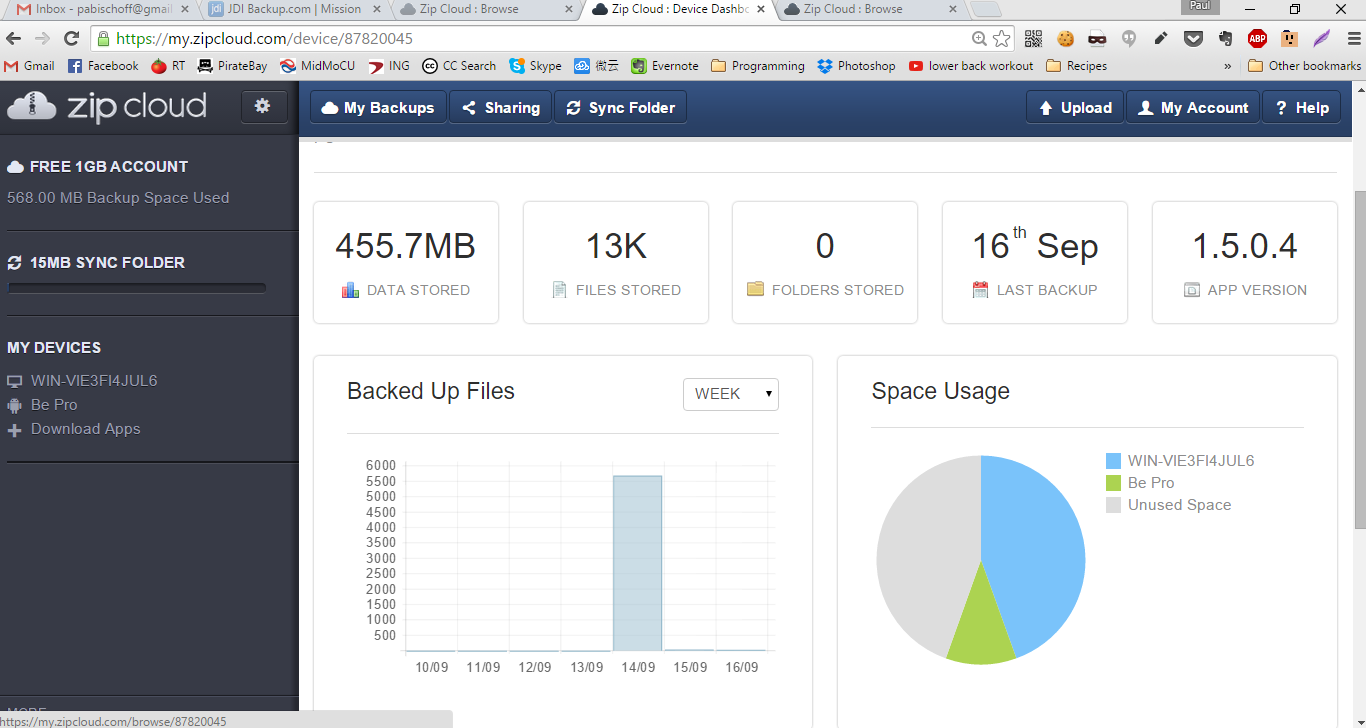ZipCloud has a bad reputation. A Google search for the online cloud backup service will bring up reviews and articles with no shortage of rage in the comments sections. But has the company evolved from the shady sales practices that earned it so much hate? Is it really as bad as they say? How does it compare to our top rated services such as iDrive? We took it for a spin to find out.
Features, space, and pricing
On the surface, ZipCloud is cheap. Really cheap. For less than $5 per month, you can have the middle-tier premium plan with 250GB of storage space on as many computers and smartphones as you can fit.
But unless you want to be one of those angry commenters we mentioned, you had best read the fine print. Everything that isn’t explicitly listed in the terms for a plan – even the so-called “unlimited” plan at the highest tier – will cost extra. Want a sync folder bigger than 2GB? Tack on a couple bucks per month. Want hourly backups instead of daily? A couple more. Want to back up external hard drives? That’s more, too. Backing up videos? Grab the credit card. Speedier backups? More nickels and dimes. It’s easy to see why customers get fed up, especially when ZipCloud isn’t exactly transparent about what is and isn’t included in a plan.
ZipCloud offers a free trial with 1GB of storage space and a 15MB sync folder. The sync folder differs from the standard backup in that it always keeps the most updated versions of its files at the ready on all your devices. Backup simply means copying files from one location to the other. To update the files on all devices, a backup must be scheduled and performed again, then manually downloaded to other devices.
Upon initial backup, you can choose which files and folders are downloaded manually or go with the default. Full system backups are not available, so ZipCloud is mainly for your documents, pictures, music, and whatever else is in your user files. You may not, for instance, back up entire applications.
Filters can be applied to block files with specified extensions or larger than a certain size. Options for those with weaker PCs and slower connections are a nice touch. You can adjust how the program utilizes system resources to speed up backups (makes other programs slower) or switch to “light” (slower backups, less system resources consumed). Additionally, turn on the Volume Shadow Copy option to backup files that are locked or in use, although this may decrease speed of backups and increase memory usage.
The incremental file backup function only uploads parts of a file that have changed. This is also useful for those with limited bandwidth.
File sharing with friends and colleagues can be done using either a public link or via email. Public links can be shared to social networks including Pinterest, Google Plus, Twitter, and Facebook. Keep in mind that sharing to a social network will just post a link to a download page for the selected file or folder. It will not post photos or other media natively to Facebook, for instance.
At this point, it’s worthwhile to note that ZipCloud is nearly the exact same service as three other cloud backup brands out there: MyPCBackup, JustCloud, and Backup Genie. They are all four made by the same parent company, JDI Backup. Other than the logo and the color scheme, they are carbon copies of each other. They even all use the same customer database, meaning you must sign up with a different email address if you want to use more than one.
Security
ZipCloud will protect the transfer of data from your device to the cloud, but that’s about it. Once it’s on the cloud, it sits there without encryption of any kind. If privacy is even remotely a concern, look elsewhere.
Because it’s not encrypted, ZipCloud is free to weed through your stuff. The terms of service dictate the company is permitted to manually search through customers’ files. Customers have complained that the company disallows pornography and pirated content. Sensitive personal info is obviously a no-no as well.
To make matters worse, JDI doesn’t even own its own servers. All your files are stored on Google Cloud Storage servers in the USA and European Union. That means, if it wanted, Google (and law enforcement that Google cooperates with) can also access all of your files.
Interface
ZipCloud is available as a web app, mobile app, and desktop app. Rather annoyingly, each one has features and functions not available on the other platforms, so it doesn’t keep a consistent interface across all apps.
The desktop app looks dated but is easy to figure out. Hit “Start Backup” to backup everything in your selected files. Use “drag and drop” to add single files. Everything is stored in the same file structure as on your PC. The Restore tab lets you navigate the file tree and choose which files and folders to recover. Unfortunately, there’s no search function, so you just have to remember where exactly you saved that receipt from six months ago. The desktop browser also doesn’t allow you to preview image thumbnails, although this is possible in the web and mobile apps.
Clicking “My Files,” “Sync Folder” or “Control Panel” opens the web app in your default browser. The web app looks much more modern than its desktop counterpart. From here, you can access files from all of your devices, although there’s still no search function. You can only upload files to the Sync folder, which supports drag and drop. Uploading files to your normal backup has to be done through the desktop app. Sharing and managing public links also happens here, but not in the desktop version. It starts to get confusing remembering what functions can be performed on which platforms.
The browser also functions as a dashboard where you can view logs, space used, and a list of connected devices. Here you can also use the Locate feature to find lost or stolen devices.
Downloading a file from the browser simply puts a ZIP file in your download folder, but restoring from the desktop app will place it in it’s original location.

The mobile app is the best of the bunch. It allows for automatic photo backup, but not videos. Other files can be uploaded manually as well, but only to the much smaller Sync folder. You can download any file from your PC’s backup. Sharing files is just a long-press away. Media like photos and videos can be previewed from within the app. It can even perform remote backups on your PC.
Other bonus features include the ability to record voice memos, write text files, and draw doodles that are instantly uploaded to the Sync folder. Unfortunately, there’s no way to directly move a file from your backup to the sync folder – it has to be re-uploaded manually.
Customer service
You can’t call or live chat with ZipCloud. Instead, customers must submit tickets explaining their problems on the website. It usually takes less than a day for someone to respond.
In my case, several files and folders were not showing up in my backup, despite the app saying it had completed the upload. I had three separate email chains going by the end, each with a different customer service rep, and no one was able to explain the missing files. While the staff seemed to take the request seriously, they ultimately couldn’t determine the reason behind the vanished files.
My customer service experience was actually fairly positive on the whole; much better than expected. But the issue is still unresolved, and there’s only so much they can do before you just have to accept that ZipCloud has some bugs to work out. Even after completely wiping the backup, reinstalling the desktop client, and removing my PC from the account, I still had the same problem (on Windows 10, in case you were wondering).
ZipCloud’s website is mainly a surface-deep sales pitch, without much documentation and difficult-to-find details about services (and those pesky add-ons).
ZipCloud and its sister services get a lot of flack for constantly trying to upsell better plans and add-ons. In my experience, yes, there were a few ads and emails, but I didn’t find them to be over the top. The more misleading practice is, in my opinion, the many hidden add-ons that customers might otherwise assume are included in their plan.
Finally, if you decide ZipCloud isn’t for you, uninstalling and cancelling an account takes less than five minutes.
So is ZipCloud a scam? It has a confusing, non-transparent sales model that’s designed to dupe those who don’t read the fine print, but I wouldn’t go so far as to say it’s doing anything illegal. If you want a dirt-cheap cloud backup solution with a solid mobile app, you’re aware of what you are and aren’t getting, and you’re not concerned about security, then it’s an acceptable service. For most people however, this won’t be the case.






All ZipCloud reviews
All Star ZipCloud reviews
All ZipCloud positive reviews
All ZipCloud critical reviews
All related ZipCloud reviews
See all reviewsMy zipcloud backups have been unavailable since August. Numerous threads with support but no resolution. I get the same run around every time from support.
STAY AWAY. This not a legitimate service.
Zipcloud sold me an “unlimited data backup” plan. But instead, they stopped backups without notice to me because I violated a “fair use policy.”
I signed up for a two year unlimited data storage backup plan with Zipcloud. Without telling me, they claim I violated their fair use policy because my backed up data exceeded 1 TB – so they blocked my account, and stopped backing up my new date – without even sending me an email telling me that they were doing that. Months went by. Each day, I would check on my computer and the zipcloud account showed that a backup had been completed. But eventually, I went onto the zipcloud website to double check that my files were being properly backed up and discovered that they had stopped backing up new files at some point in the past. No notice to me. When I went to a zipcloud chat with their representative, they said that I had agreed to a fair use policy when I signed up. That is different than I recall – I recall an “unlimited data storage plan” and I have an email from zipcloud that clearly states that. When I asked to cancel and get a refund, I was advised by their agent that there was nothing left to refund. They also suggested that I keep my account active and instead go back and delete old files that I no longer needed to back up. To me, that is the dog wagging the tail of the cat. I signed up for an unlimited data storage backup plan so that I would not have to think about backup issues – it would always back up all files. I have no desire or time to figure out what to delete so that I can keep my backup file under 1 TB. Be careful with Zipcloud.
I have not been able to access my files for 2 months. I have contacted them multiple times via online chat, and by calling. Every time they give me a run around by telling they have sent several scripts to fix the issue, and it has not worked, but the development team is working on it. Then their incompetent developers couldn;t fix it, then it got escalated to what they call senior development team, and it has been three weeks since it was escalated, and nothing. And when I contact them again todat here is what they said…..>>>>>>>>>> We understand your concern regarding files not accessible from control panel, do note that our development team had run a script on your account to fix your issue.
I understand that you are still facing the issue, our development team will apply more fixes to your account. Regrettably it will take some more time to apply those fixes.”<<<<<<<—————————————
Who with right mind would accept such stupid answer, this shit software of theirs is supposed to backup my critical data, and it hasn't worked for 2 damn months, and that's their answer every single time. Incompetent scam artists. Stay away from this company.
Zipcloud is indeed failing to backup various random directories, that have been selected for backup in their Control Panel. I have been after a fix for around 5 weeks now, but have just been getting the run around. Based on this experience, I’d have to say that Zipcloud is a defective product and fails to do the very thing I bought it for – ie: backing up my files.
5 months ago, when I asked ZipCloud to cancel my account, due to loss of service, due to technical problems that their tech support was UNABLE to resolve, and due to them LOSING 2- years-worth of my files — they went ahead and charged my credit card IMMEDIATELY, ON THE SAME DAY I CANCELLED, instead of waiting till my February renewal date.
When my CC bank contacted them they said no refund would be issued since “he cancelled in less than the 30 days mentioned in the contract.” Then, when I talked to their agent, they AGREED TO CANCEL MY ACCOUNT AND ISSUE A REFUND. When no refund was showing in my CC account, I called them again. This time they claimed the refund will be issued in 90 days.
When 90 days passed I called again. They claimed the money should be refunded soon. OK, you guessed it, no refund.
Couple weeks later I called again. This time they simply said NO REFUND. Why? because I filed a dispute with my CC bank before contacting them. Meanwhile, since they promised a refund, my CC bank closed the dispute file, and can’t open it again, which ZipCloud must have planned it well ahead.
So no product, no refund, Ciao, baby.
Stay away!